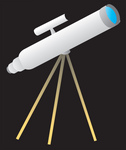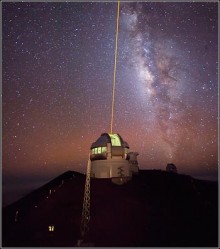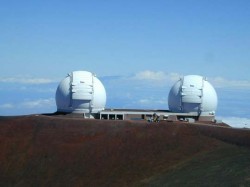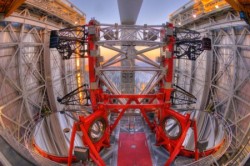Written by Tammy Plotner

What is an optical telescope? How does it work? What types of optical telescopes are there? What are some terms I might encounter when I am studying about this type of telescope? What do they mean? What optical telescopes are famous? If you have questions like these, then follow along as we take a closer look at the optical telescope…
What Is An Optical Telescope?

An optical telescope is an instrument used to gather and focus light from a very specific portion of the electromagnetic spectrum. It generally refers to the wavelengths of light which can be perceived by the human eye. These wavelengths are then magnified and studied "optically" – via direct viewing, photographically, or collected on a photo sensor. There are three primary types of optical telescopes: the refractor, the reflector and the catadioptric telescope.
How Does An Optical Telescope Work?

At the heart of all optical telescopes is the major light gathering source. In the optical refractor telescope, this is called the primary objective lens. In the optical reflector telescope, it is known as the primary mirror. In the optical catadioptric design, it is also a primary mirror. These gather the incoming light from a distant object and focus it back along a path called the focal plane. When the light rays re-converge, they form a "real image" or reach a focal point. This image may then be gathered by the optical telescope's cameras or photo sensors – or it may be magnified by an additional series of lenses called an eyepiece and studied by the human eye.
Terms Associated With An Optical Telescope

There are many terms associated with an optical telescope, but there are a few which might might commonly encounter. While these are far from all you'll find, they will help explain the many different terms expressed by astronomers who use optical telescopes and terms you may find in advertisements or instructions with personal optical telescopes.
Aberrations: Aberrations are nothing more than a flaw in the performance of an optical system. Types of aberration include blurring of the image produced by an image-forming optical system. It occurs when light from one point of an object after transmission through the system does not converge into (or does not diverge from) a single point.
Aperture: Aperture is a simple work that expresses the diameter of the primary light gathering source of any optical telescope – not just the size of the opening. For example, a reflector telescope with a 4.5" mirror would have an aperture of 114mm. A refractor telescope with a front lens diameter of 6" would have an aperture of 150mm.
Chromatic: Chromatic aberration of a lens is seen as "fringes" of color around the image, because each color in the optical spectrum cannot be focused at a single common point on the optical axis.
Coma: Another type of aberration is coma, which derives its name from the comet-like appearance of the aberrated image.
Dawe's Limit: Dawes' limit is a formula to express the maximum resolving power of a microscope or telescope. It is so named for its discoverer, W. R. Dawes, although it is also credited to Lord Rayleigh.
Diffraction Limit: The diffraction limit is the minimum angular separation of two sources that can be distinguished by a telescope depends on the wavelength of the light being observed and the diameter of the telescope.
Focal length and f-ratio: The focal length of an optical telescope is the length of the light path to form a real image. These numbers help to determine how wide the visual field can be achieved with a particular eyepiece or photographic equipment. The f-ratio of an optical telescope is the ratio between the focal length of the telescope and the diameter of the primary light gathering source. Low f-ratios, such as f/4 indicate wide fields of view with low practical magnification limits, while high f-ratios, such as f/10 indicate restricted fields with high practical magnification limits.
Meniscus: Convex-concave (meniscus) lenses can be either positive or negative, depending on the relative curvatures of the two surfaces. To obtain exactly zero optical power, a meniscus lens must have slightly unequal curvatures to account for the effect of the lens' thickness.
Optical Coating: An optical coating is a process of placing thin layer of material on an optical component such as a lens or mirror which alters the way in which the optic reflects and transmits light. One type of optical coating is an antireflection coating, which reduces unwanted reflections from surfaces, and is commonly used on refractor telescope lenses. Another type is the high-reflector coating which can be used to produce mirrors which reflect greater than 99% of the light which falls on them – used in reflector telescopes.
Optical Path: The path that light takes in traversing an optical system is often called the optical path. The physical length of an optical device can be reduced to less than the length of the optical path by using folded optics.
Practical Magnification: The magnification, or power, of the telescope depends on two optional characteristics: the focal length of the main telescope and the focal length of the eyepiece used during a particular observation. Both minimum and maximum practical magnifications can apply and are determined by the telescopes focal ratio.
Resolving Power: Resolving power is the ability of the components of an optical instrument to measure the angular separation of the points in an object. The term resolution or minimum resolvable distance is the minimum distance between distinguishable objects in an image.
Wavefront Error: Wavefront is an imaginary surface joining all points in space that are reached at the same instant by a wave propagating through a medium – such as optics. Wavefront error is expressed in fractions, such as 1/25, which reveals the optics abilities to accurately focus the light waves.
Just A Few Famous Optical Telescopes
Are you interested in some of the most famous optical telescope of all? While some of these telescopes also equipped to use other portions of the electromagnetic spectrum, like all humans, we enjoy what we can see! How many of these do you recognize?

Hubble Space Telescope: The Hubble Space Telescope is a 2.4 meter aperture telescope in space. Images are not limited by atmospheric seeing. They are therefore diffraction limited. The seeing of typical HST images is resolved at about 0.1 arcsec. Observations can be made at wavelengths that are blocked by the atmosphere from the ground, particularly in the ultraviolet.

Kitt Peak: Kitt Peak National Observatory (KPNO), part of the National Optical Astronomy Observatory (NOAO), supports the most diverse collection of astronomical observatories on Earth for nighttime optical and infrared astronomy and daytime study of the Sun. Founded in 1958, KPNO operates three major nighttime telescopes, shares site responsibilities with the National Solar Observatory and hosts the facilities of consortia which operate 19 optical telescopes and two radio telescopes. (See the Tenant Observatories list.) Kitt Peak is located 56 miles southwest of Tucson, AZ, in the Schuk Toak District on the Tohono O'odham Nation and has a Visitor Center open daily to the public.

Gemini Observatory: The Gemini Observatory consists of twin 8-meter optical/infrared telescopes located on two of the best sites on our planet for observing the universe. Together these telescopes can access the entire sky. The Gemini South telescope is located at almost 9,000' elevation on a mountain in the Chilean Andes called Cerro Pachon. Cerro Pachon shares resources with the adjacent SOAR Telescope and the nearby telescopes of the Cerro Tololo Inter-American Observatory. The Frederick C. Gillett Gemini North Telescope is located on Hawaii's Mauna Kea as part of the international community of observatories that have been built to take advantage of the superb atmospheric conditions on this long dormant volcano that rises almost 14,000' into the dry, stable air of the Pacific. The Gemini Observatory's international headquarters is located in Hilo, Hawaii at the University of Hawaii at Hilo's University Park.

Palomar Observatory: The Palomar Observatory is located in northern San Diego county, about 70 miles northeast of the San Diego airport. It has been in operation since 1948. The 200-inch (5 meter) Hale telescope is jointly operated by Cornell University, the California Institute of Technology and the Jet Propulsion Laboratory. Cornell astronomers have access to one quarter of the observing time, and use the 5m to conduct observations in the optical and infrared wavelength regimes.

Keck Observatory: From a remote outpost on the summit of Hawaii's dormant Mauna Kea volcano, astronomers at the W. M. Keck Observatory probe the deepest regions of the Universe with unprecedented power and precision. Their instruments are the twin Keck Telescopes, the world's largest optical and infrared telescopes. Each stands eight stories tall and weighs 300 tons, yet operates with nanometer precision. At the heart of each Keck Telescope is a revolutionary primary mirror. Ten meters in diameter, the mirror is composed of 36 hexagonal segments that work in concert as a single piece of reflective glass.

Lick Observatory: The University of California's Lick Observatory, located in the Diablo Range east of San Jose, California, has a long and fascinating history. The legacy of the eccentric California millionaire James Lick, the Observatory was founded in 1888 and has been part of the University of California ever since. Lick Observatory has grown to keep pace with the changing demands of astronomy, and, after more than a century of operation, remains among the most productive research observatories in the world. Lick Observatory is open to daytime visitors nearly every day of the year. The Observatory is closed to the public on Thanksgiving Day, Christmas Eve and Christmas Day, and at night after 5:00pm.

Yerkes Observatory: By chance the new Professor of Astrophysics at the University of Chicago, George Hale, discovers that two optically perfect disks are available. These 42-inch "blanks" could be ground to create a 40-inch refracting telescope, the largest in the world. He and the dynamic president of the university set off to find a donor willing to purchase these disks; build the telescope; and pay for a "suitable observatory" to house the World's Largest Telescope. Yerkes Observatory occupies a unique niche for the education and the scientific community. It bridges several important perspectives in formal and informal education. The history of astronomy and astrophysics of the observatory is a solid foundation for introducing all the important topics in current research as well as the practice of observational astronomy.

Mount Graham International Observatory: The Mt. Graham International Observatory is located on Mt. Graham in the Pinaleno Mountains near Safford , Arizona. The observatory site is operated by the University of Arizona. Mt. Graham is part of the Coronado National Forest . The construction of the Observatory was approved by Congress in November of 1988. Two telescopes are now in operation, the Vatican Observatory/Arizona 1.8m Lennon optical telescope (VATT) and the 10m diameter Heinrich Hertz Submillimeter Telescope (SMT), a joint project of Arizona and the Max-Planck-Institut für Radioastronomie, Germany. The preliminary indications are that both the site and the telescopes will reach highest expectations. The carbon fiber Hertz telescope is proving very stable, and the surface adjustment has surpassed its goal of 15 microns rms. The Lennon telescope with its f/1 primary figured to 17 nm rms is now in regular astronomical use. The third and largest telescope for Mt Graham is the 2 x 8.4 Large Binocular Telescope (LBT); it is a partnership between Arizona, Ohio, Italy (Arcetri), Germany and the Research Corporation.

South African Astronomical Observatory: The South African Astronomical Observatory (SAAO) is the national centre for optical and infrared astronomy in South Africa. It is a facility of the National Research Foundation under the Department of Science and Technology. Its prime function is to conduct fundamental research in astronomy and astrophysics by providing a world-class facility and by promoting astronomy and astrophysics in Southern Africa. SAAO headquarters are in the suburb of Observatory in Cape Town. The main telescopes used for research are located at the SAAO observing station near Sutherland in the Northern Cape, a 4 hour drive from Cape Town. The Southern African Large Telescope (SALT) is the largest single optical telescope in the southern hemisphere, with a hexagonal mirror array 11 metres across. Although very similar to the Hobby-Eberly Telescope (HET) in Texas, SALT has a redesigned optical system using more of the mirror array. It will be able to record distant stars, galaxies and quasars a billion times too faint to be seen with the unaided eye – as faint as a candle flame at the distance of the moon.

Aucun commentaire:
Enregistrer un commentaire